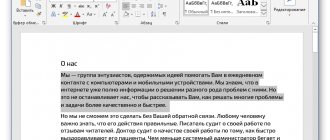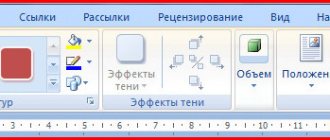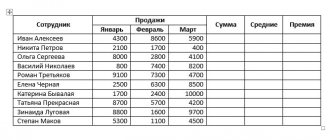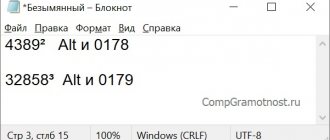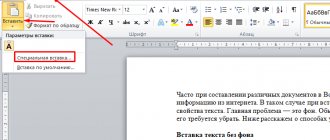Good day, dear readers of this blog! Fedor Lykov is in touch. Today we will look at the question “how to insert a formula into Word.” This question is very relevant for students or schoolchildren when preparing scientific papers, especially given the current trend of distance learning.
Adding it to your document will not be difficult. Let's look at the options available. This article will affect all editions of the office, starting from 2003 and affecting all subsequent ones (2007, 2010, 2013, 2020 and 2019).
Today we will look at several input methods:
- Using the Microsoft Equation 3.0 add-in
- Using a template
- Manual input
- Handwriting
Let's not linger any longer on the introduction and let's get started with the analysis.
Inserting a formula in Word 2003.
Let's start with the oldest program. Despite its venerable age, this office edition is still used by many users who do not want to accept the innovations of more recent versions.
The 2003 edition of Office has poorer equation creation tools than the newer editions of Office. To create them, the Microsoft Equation 3.0 add-on is used. Let's look at it.
First, open a document or create a new one. Now you need to go to the “Insert” menu at the top of the screen and select “Object” from it.
Click on it with the left mouse button and a window will open with the selection of the required object. We need the item “Microsoft Equation 3.0”. Select it and click “OK”.
A small toolbar will appear before our eyes with the available categories of symbols and signs necessary to create an equation. There are:
- relationship symbols
- bracket patterns
- problems and dots
- Fraction and radical patterns
- superscripts
- superscript and subscript patterns
- operators
- matrix templates
- integrals
And much more. In 95% of cases, I think you can create the formula you need without any problems.
Simply select the symbol you need from a specific category, and it will appear in the line of your equation in the text.
To edit a formula, double-click on it with the left mouse button and a panel with symbols will appear in front of you again.
Now I propose to consider the possibilities of composing equations in more modern versions.
How to create your own formula in Word
If the required formula is not among the templates, you can assemble your equation in a special constructor using a library of mathematical symbols.
1. Click “Insert” → “Equation” (“Formula” on macOS).
2. Use the tools in the “Design” menu that opens. Thanks to them, you can insert and edit various mathematical symbols and structures: matrices, fractions, logarithms, parentheses, roots, diacritics, integrals and so on.
Insert a formula in modern Word using a template
As we already know well, modern versions have a more advanced and convenient graphical interface. Also in the modern office package there are templates for equations that are most common in algebra and geometry.
For example, you are here, according to the standard there are:
- quadratic equation
- area of a circle
- sum expansion
- Taylor series
- Fourier series
- Pythagorean theorem
- Trigonometric identities
If these templates are not enough, then you can download additional ones from the Internet, which can be done directly from the program itself. There you can find equations from physics and very complex formulas like the Laplace operator. In general, there are very enough of them.
So, let's look at how to insert a formula into Word.
Create a new text document for example or open a ready-made one.
Next, we turn to the “Insert” tab, in which we need the rightmost corner at the top of the toolbar. To open the list of templates, click on the small arrow next to the “Equation” button.
When we click on the arrow, a menu will open with a choice of an equation template. Select the one you need and left-click on it, and it will appear in your text.
After inserting the desired equation, you can enter your values there or change it from the top toolbar, which will change to work with formulas. In it you can add the meaning and signs you need.
As I already mentioned, it is possible to download additional templates. To do this, refer to the drop-down list at the bottom of the menu called “More equations from office.com.”
Why and who needs formulas
Of course, not all text editor features are needed by every user. There are a lot of them, and it’s unlikely that any of us owns them all. For example, I rarely need to put footnotes at the bottom of a document, but if you are writing a book, then you cannot do without them.
Working with formulas is needed not only by students and those who write scientific papers in mathematics, physics or chemistry. In fact, sometimes you need to put a degree symbol, add a superscript or subscript in the simplest text for a wide range of readers. You can do without the standard functions of the program and type the text manually, but it will look ugly and unprofessional.
Many simple and not so simple problems can be solved by inserting formulas into a document, so I think this option is useful for everyone.
Manual input
The built-in Word toolkit allows you to manually enter the necessary signs and elements of the equation, thereby you have the opportunity to create your own formula.
You need to go to the “Insert” tab and click on the “Equation” button. The only difference with the previous method is that here we need the button itself, and not the small arrow next to it.
The panel at the top will allow you to add various elements of your formula. For example, logarithms, integrals, parentheses, roots, fractions, and so on.
In order to save a formula in templates (for example, if it is used often in your course work, and entering it every time will not be the most rational solution), you need to select it by clicking on the three dots in the upper left corner.
After that, go to the “Insert” tab, click on the small arrow next to the “Equation” button and at the very end of the list that opens, click “Save the selected fragment to the collection of equations.”
After clicking, a window will appear in which you can enter the name of your formula, select a collection and category. After selecting all the parameters, click “OK” and you will be able to see it in the general list with the rest of the built-in templates.
Method 3: Codecogs
A site called Codecogs is optimal for those users who create formulas with the need to further translate them into LaTeX format or in situations where editing is already carried out in this format. Codecogs allows you to add various components of formulas while simultaneously displaying them in the classic version and the one mentioned above.
Go to Codecogs online service
- Once on the main page of the Codecogs website, check out the top panel, where all elements are added. Click on one of the blocks to expand the available options or directly place it in the field.
- In the editor you will see a representation in LaTeX and can enter the necessary numbers.
- Below is the classic view, which in the future can be saved as a separate file on your computer.
- Use advanced appearance customization features to change the font, background, or text size.
- Additionally, in the drop-down menu, select the format in which the file will be saved on your hard drive.
- Click on the specially designated clickable inscription to start downloading the file with the finished formula in the selected format.
- Wait until the download is complete and use the ready-made equation.
Note that for editing LaTeX it is best to use separate editors that are specifically designed for this. You will find more detailed information on this matter in another article on our website by clicking on the link below.
Read more: How to edit LaTeX text online
We are glad that we were able to help you solve the problem. Add the Lumpics.ru website to your bookmarks and we will be useful to you. Thank the author and share the article on social networks.
Describe what didn't work for you. Our specialists will try to answer as quickly as possible.
Handwriting
Let's move on to the final and, in my opinion, most interesting and convenient way for entering formulas into Word. The absence of this function in the 2003 version of Office is really very depressing, especially when you use handwriting input at least once.
To create them, go again to the “Insert” tab and click on the small arrow next to the “Equation” button, and select “Handwritten Equation” from the menu.
A window will open in front of you in the form of a sheet of paper, on which you can draw all the elements you need using the left mouse button. At the top of the drawing area, the program will immediately show you an example of how it determines your input of characters. See my example to see how this happens.
There are only 4 tools with a trivial purpose:
- “Write” is a tool for drawing characters.
- “Erase” is a tool for erasing characters.
- Select and Fix is sort of like Photoshop's lasso, but in this situation it helps highlight some of your drawn characters and help the program identify them correctly.
- “Clear” will simply erase all the characters you have drawn.
After finishing the input, click on the “insert” button.
Our equation will be added to the text.
This method will help save a lot of time. I learned too late about this method, but I could have used it when writing my coursework!
These are all ways that will allow you to introduce equations into your text. Let's look at options for introducing formulas into tables. This is usually relevant for Excel users, but in Word you can also use some functions similar to Excel. Read and I'll tell you how.
How to edit and move ready-made formulas
We've sorted out the creation of equations, let's move on to editing. To change the formula, left-click on it. You can simply change the parameters manually, and if you need to use the built-in functions, then go to the “Designer” tab.
To change the font, highlight a formula, or make other changes to its appearance, use the standard set of Word functions. Select the object and choose the appropriate tool from the Home menu tab in the Font panel.
To move a ready-made mathematical expression, there are 2 ways. Left-click on it, then, holding it on the 3 dots in the left corner, drag the object across the document. Watch out for the dark black bar, that's the cursor. Where it is located is where the formula will appear when we release the mouse button.
I often use another method. I select the formula and press “Ctrl + X” to cut it. Then I move the cursor to the place where I want to move the equation and use the key combination “Ctrl + V”.
This method is especially good if you need to “drag” the expression far away.
How to insert a formula in Word into a table
Sometimes Word users have to create tables with regular formulas that, for example, count numbers in adjacent cells. I described how to create an Excel table in a Word document in a previous article.
Here I'll talk about regular tables and how to add simple formulas to cells. They are very much inferior in functionality to those in Excel, but for basic calculations they may be sufficient.
So, take a ready-made table or create a new one. Of course, this should be a table that is filled with numbers. Select the cell in which you need to insert the formula.
Now we need a “Function” button, which is located in the “Layout” tab.
A window for entering the required function will open. There are not many commands, but describing each of them is material for a separate article, so if necessary, I recommend that you refer to the reference material from the developers
How to insert a formula in Word 2010 if it is not active
Sometimes you may notice when working with a document that the “Equation” button is not active, and you need to insert a formula. What to do?
This question arises for many users, but it can be solved very simply.
This problem is connected with the fact that before 2007 the office format of text files was .doc, and after that it was more advanced - .docx.
Working in the old format deprives you of many of the advantages of modern office versions, so I offer you a solution that will help you convert your old .doc document into a modern one and, as a result, eliminate the problem.
So, you are in an old format document and you need to write an equation. All you need to do is go to the “File” tab and there select the “Information” item, in which you need to click the “Convert” button.
A confirmation window will appear in which we click “OK”.
After conversion the problem will disappear.

